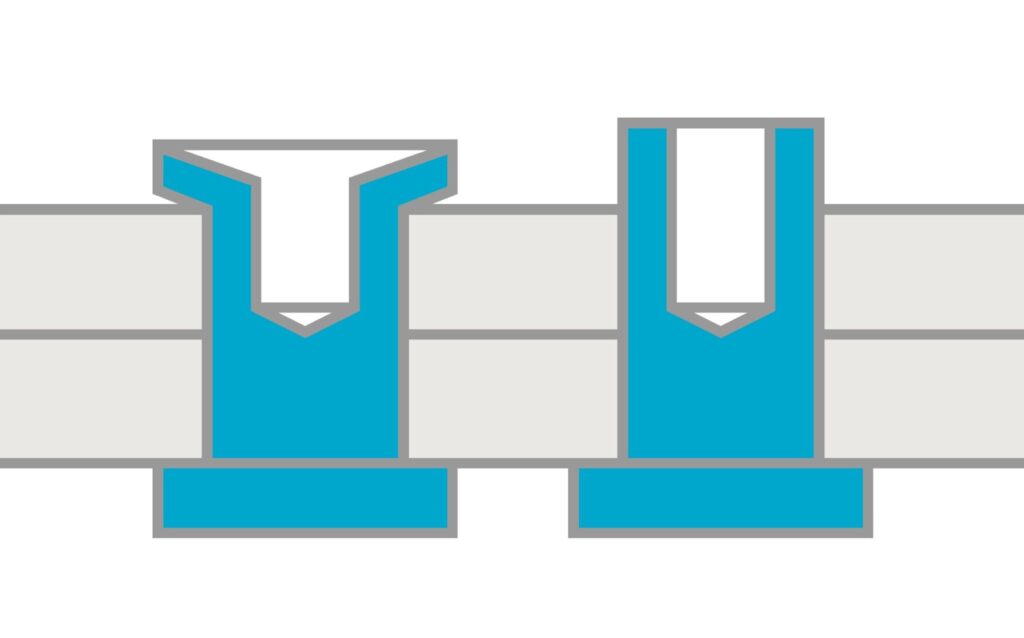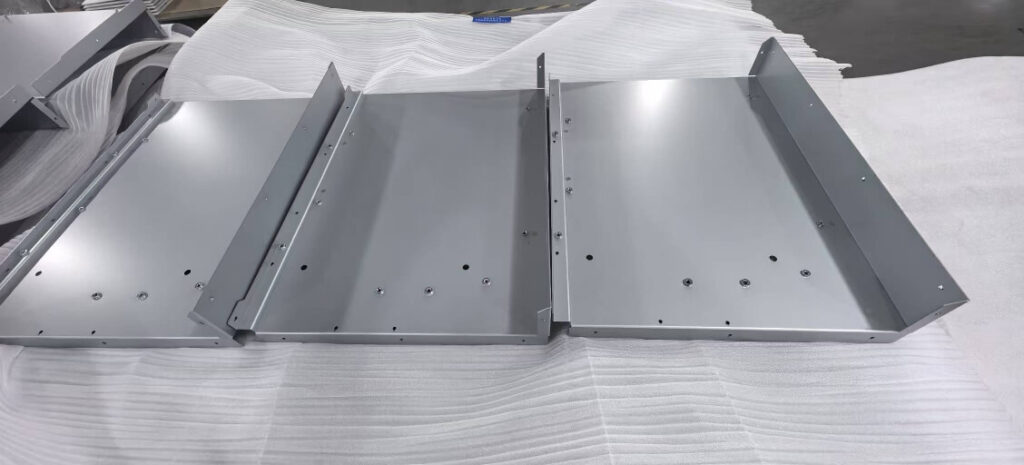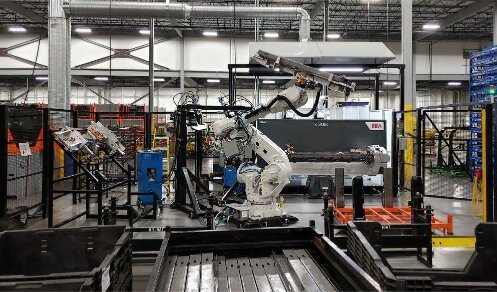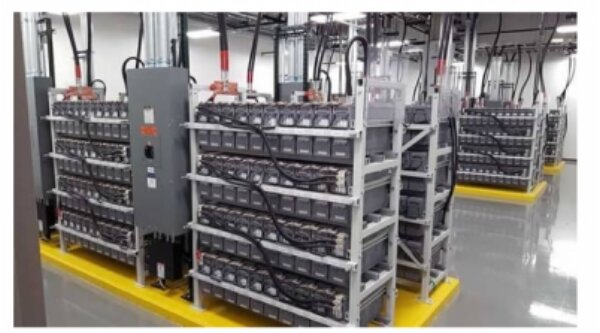При соединении металлических деталей важно выбрать такой метод, который был бы одновременно прочным и экономичным. Многие отрасли сталкиваются с проблемой создания надежного соединения между металлическими деталями. Прессовая клепка предлагает решение. Она позволяет надежно соединять детали без использования дополнительных крепежных элементов. Этот метод эффективен и надежен, что делает его популярным выбором для многих областей применения.
Прессовая клепка имеет ряд преимуществ перед другими методами соединения. Она быстрее и экономичнее, чем сварка. Хотите узнать, чем она отличается от других методов? Давайте разберемся.

Что такое процесс соединения с помощью пресс-клепки?
Процесс соединения с помощью пресс-клепки скрепляет материалы путем вдавливания заклепок в отверстия. При этом заклепка помещается в предварительно просверленное отверстие, а затем на нее оказывается давление с помощью пресса. В результате заклепка расширяется, создавая плотное и прочное соединение между материалами.
Этот метод обеспечивает прочное и долговечное соединение без применения высокой температуры и сложного оборудования. Он широко используется в таких отраслях, как автомобильная, аэрокосмическая и электронная, где требуется прочность и точность.
Как работает пресс-клепка?
Прессовая клепка создает прочные, неразъемные соединения за считанные секунды. Процесс выполняется в три простых шага, что делает его идеальным для высокоскоростных производственных линий.
Подготовка отверстий
Сначала просверлите одинаковые отверстия в соединяемых материалах. Отверстия должны идеально совпадать. Их диаметр должен быть немного больше стержня заклепки, но меньше ее головки.
Установка заклепок
Затем вставьте заклепку в предварительно просверленные отверстия. Головка заклепки остается с одной стороны, а стержень проходит через все слои. Выберите длину заклепки в зависимости от общей толщины материала.
Нажав
Наконец, гидравлический или пневматический пресс прикладывает усилие к хвостовику заклепки. Это усилие разгибает заклепку, создавая вторую головку, которая фиксирует материалы вместе. Соединение становится прочным и устойчивым к вибрациям.

Виды методов клепки
Существует два основных вида клепки: прямая и непрямая. Выбор между ними зависит от материалов, области применения и производственных потребностей. Давайте рассмотрим оба метода более подробно.
Прямая клепка
Прямая заклепка - наиболее распространенный и простой тип заклепки. При этом методе заклепка помещается непосредственно в материал, и прикладывается давление, чтобы расширить заклепку и закрепить соединение.
Этот быстрый и эффективный процесс идеально подходит для массового производства, где требуется высокая скорость и большие объемы. сборка необходимы.
Косвенная клепка
Непрямое заклепывание требует дополнительных действий. При этом методе заклепка сначала помещается в держатель или приспособление. Приспособление помогает позиционировать заклепку перед ее установкой в материал. Оно обеспечивает правильное выравнивание заклепки на этапе прессования.
Непрямая клепка используется для более сложных задач. Она полезна, когда требуется повышенная точность или когда заклепку нужно установить в труднодоступном месте. Этот метод позволяет лучше контролировать введение и расширение заклепки, создавая более прочное соединение.
Преимущества прессовой клепки
Прессовая клепка имеет множество преимуществ, которые делают ее популярным выбором для производства. От прочности и долговечности до экономии средств - давайте рассмотрим основные преимущества использования пресс-клепки в производстве.
Прочные, долговечные соединения
Одним из наиболее значимых преимуществ прессовой клепки является ее способность создавать прочные и долговечные соединения. Процесс обеспечивает правильное расширение заклепок внутри материалов, создавая надежное и долговечное соединение.
Экономическая эффективность процесса
Прессовая клепка - экономически выгодное решение для многих производителей. Она не требует дорогостоящего оборудования или уникальных материалов, что делает ее более доступной по сравнению с такими методами, как сварка. Кроме того, этот процесс сокращает отходы материалов, поскольку заклепки идеально вставляются в предварительно просверленные отверстия.
Скорость и эффективность производства
Прессовая клепка - это быстрый и эффективный процесс, позволяющий производителям быстро изготавливать большое количество деталей. Процесс может быть автоматизирован, что обеспечивает неизменность результатов каждый раз. Благодаря прессовой клепке производители могут оптимизировать свои сборочные линии и повысить общую производительность.
Минимальная необходимость в постобработке
После установки и закрепления заклепки дополнительная обработка обычно практически не требуется. Соединения, полученные с помощью прессовой клепки, прочны и часто не нуждаются в дополнительной обработке. отделка.
Требования к прессовой клепке
Для успешного процесса прессовой клепки необходимо учитывать определенные факторы, чтобы обеспечить прочное и надежное соединение. Вот основные требования к прессовой клепке.
Подготовка пилотных отверстий
Пилотные отверстия необходимы для процесса пресс-клепки. Эти отверстия должны быть тщательно просверлены в соединяемых материалах. Размер и расположение отверстий должны быть точными, чтобы обеспечить правильную посадку заклепки и ее расширение при приложении давления.
Если отверстие слишком большое или маленькое, это может привести к слабому или неровному соединению. Для успешного процесса клепки необходимо убедиться, что отверстия расположены правильно и соответствуют требуемому размеру.
Свойства материала заготовки
Свойства соединяемых материалов также играют важную роль в процессе прессовой клепки. Материалы должны быть достаточно прочными и толстыми, чтобы выдержать давление, оказываемое при клепке.
Более мягкие материалы, например алюминий, могут потребовать более мягких заклепок или других материалов, чтобы избежать повреждений. Материалы также должны быть совместимы с типом используемых заклепок. Различные материалы по-разному взаимодействуют с заклепками под давлением.
Соображения по геометрии соединений
Конструкция соединения так же важна, как и выбор заклепки. Геометрия соединения, например количество и расположение отверстий, должна быть тщательно продумана. Это поможет обеспечить равномерное распределение давления от заклепки.
Неправильная конструкция соединения может привести к образованию слабых мест, что сделает заклепку менее эффективной. Конструкция также должна обеспечивать легкий доступ для клепальной машины, чтобы вставить и прижать заклепки должным образом.

Области применения пресс-клепки
Прессовая клепка - это универсальный метод соединения, используемый в самых разных отраслях. Давайте рассмотрим его применение в различных отраслях.
Автоматизированная индустрия
В автомобильной промышленности прессовая клепка обычно используется для сборки деталей кузова, шасси и внутренних элементов. Этот процесс обеспечивает прочность и надежность соединений даже под воздействием нагрузок и вибраций, характерных для автомобилей.
Аэрокосмическая промышленность
Аэрокосмическая промышленность требует точности и прочности, поэтому прессовая клепка является важнейшим методом соединения материалов в авиастроении. Она используется для сборки фюзеляжа, крыльев и различных внутренних компонентов.
Электроника и электрические приложения
Прессовая клепка играет ключевую роль в электронной и электротехнической промышленности, где требуются точные и надежные соединения. Она используется для соединения таких компонентов, как печатные платы, корпуса аккумуляторови разъемы.
Потребительские товары и техника
Прессовая клепка используется для сборки самых разных изделий в секторе потребительских товаров и техники, от кухонных приборов до электронных устройств. Она обеспечивает прочное и экономичное решение для соединения металлических деталей, гарантируя прочность и долговечность изделий.
Сравнение с другими методами соединения
Выбор правильного метода соединения влияет на стоимость, прочность и скорость производства вашего изделия. Здесь представлено сравнение прессовой клепки с другими методами соединения:
Клепка под давлением по сравнению со сваркой
Оба сварка и прессовая клепка создают прочные соединения, но работают они по-разному. При сварке используется тепло, чтобы расплавить и соединить материалы. Прессовая клепка, с другой стороны, использует механическую силу для расширения заклепки и соединения материалов без нагрева.
Основные различия заключаются в совместимости материалов и риске деформации. Сварка может вызвать тепловое искажение, что является проблемой для тонких или чувствительных материалов. Прессовая клепка не использует тепло, поэтому вероятность повреждения материалов ниже.
Клепка под давлением в сравнении с клеевым соединением
Клеевое соединение - еще один стандартный метод скрепления материалов. Хотя клеи могут образовывать прочные соединения, они, как правило, не могут сравниться по прочности и долговечности с прессовой клепкой, особенно в условиях высоких нагрузок.
В отличие от клеевого соединения, прессовая клепка не требует времени для отверждения или специальных условий. Ее можно использовать для многих типов материалов, включая металлы. Клеевое соединение хорошо подходит для соединения различных материалов или когда требуется гибкое соединение. Прессовая клепка, напротив, создает более жесткое, неразъемное соединение.
Прессовая клепка по сравнению с механическим креплением
Механическое крепление предполагает использование винтов, болтов или других метизов для скрепления материалов. Этот метод надежен, но часто требует дополнительных деталей и может занимать больше времени по сравнению с прессовой клепкой.
Прессовая клепка - это более быстрый и экономичный способ соединения деталей, не требующий дополнительных компонентов, таких как гайки или болты. Однако механическое крепление допускает демонтаж, в то время как прессовая клепка создает неразъемные соединения.
Заключение
Прессовая клепка - это надежный, эффективный и экономичный метод соединения материалов в различных отраслях промышленности. Она обеспечивает прочные и долговечные соединения без необходимости нагрева, что делает ее идеальной для легких материалов и крупносерийного производства.
Если вы ищете быстрое, надежное и экономичное решение для соединения деталей в рамках вашего следующего проекта, прессовая клепка может стать идеальным выбором. Связаться с нами сегодня, чтобы узнать больше или получить предложение с учетом ваших потребностей.
Привет, я Кевин Ли

Последние 10 лет я занимался различными формами изготовления листового металла и делился здесь интересными идеями из своего опыта работы в различных мастерских.
Связаться

Кевин Ли
У меня более десяти лет профессионального опыта в производстве листового металла, специализирующегося на лазерной резке, гибке, сварке и методах обработки поверхности. Как технический директор Shengen, я стремлюсь решать сложные производственные задачи и внедрять инновации и качество в каждом проекте.




